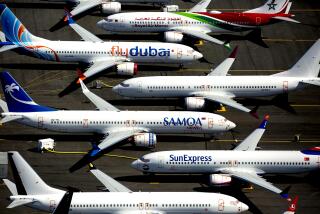Rivalry Keeps Boeing, Douglas Flying High
It has been a busy week for Boeing Co. Piedmont Airlines ordered 25 737s, with options on 30 more, on Wednesday, a day after Cathay Pacific Airways bought a couple of long-distance 747s and took options on another 10. The Seattle plane maker thus put about $1 billion of firm business on its books, with the potential that the two orders eventually could total $3.5 billion.
Good old Boeing. We Americans spend so much time moaning about how our industries can’t cope with foreign competition or make a simple good shoe anymore that it’s therapeutic to be reminded of U.S. dominance in commercial aircraft.
There, in a big ($20 billion-plus annual sales), highly technological, global business, Boeing is a clear No. 1, and McDonnell Douglas is neck and neck for the No. 2 spot with Airbus Industrie, the European consortium. Moreover, Douglas may soon steal a technological march on Airbus and take a firm hold on second position. In aircraft engines, too, U.S. manufacturers General Electric and the Pratt & Whitney division of United Technologies lead the field, with Britain’s Rolls-Royce third.
Competition’s Role
It’s nice cheering winners for a change, but self-congratulation teaches us nothing. Better we should ask what keeps the U.S. plane--and engine--makers ahead. The answer is competition--the technological competition here at home more than the foreign competition from Airbus.
Which brings us to McDonnell Douglas’ recent sale of 15 MD-88 medium-range aircraft to Delta Air Lines. McDonnell’s Douglas Aircraft division beat out Boeing for the order, which could grow to 80 planes and be worth $2 billion. Technology for the 1990s made the difference.
Delta picked the Douglas plane, a version of the MD-80 that is itself a derivative of the old DC-9, because it can be adapted more readily than could the Boeing 737 to the ultra-high-bypass engines, generically called propfans, that will become available as early as 1991. Douglas, which has been designing planes for the propfans at its Long Beach plant, has a lead in the research and was able to promise Delta an early capability with the new engines.
The propfans, which propel the plane by pushing air around and through turbine engines by means of externally mounted curved propellers, promise dramatic fuel savings over current jet engines. That’s especially important to Delta because it anticipates low-labor-cost competition now that Texas Air’s Francisco A. Lorenzo has acquired Eastern Airlines. The way Delta sees it, new aircraft will save enough on fuel and other operating outlays to equalize a competitor’s low-labor-cost advantage. Delta, exclusively a Boeing customer for almost a decade, went back to Douglas on the propfan’s promise.
One Fuels Another
Does Boeing, with an order backlog 10 times the Delta job’s value, give a hoot? You bet it does. Partly because of its loss on Delta, Boeing has stretched its 737 to a 150-seat configuration, like that of the MD-80. And it is pressing its efforts to produce a propfan aircraft, now dubbed the 7J7, by 1992. Boeing and General Electric will test an experimental propfan engine for the 7J7 this summer.
So one competitor’s advance pushes the other, and the U.S. plane makers stay ahead in the world. Airbus Industrie has a new plane, the A320, that will be available in the late 1980s but without the propfan’s fuel-saving capability. That’s a handicap because, even with low oil prices, fuel costs are a big item--equaling more than 20% of an airline’s revenue. And fuel prices are likely to be rising in the 1990s, which is when the U.S. plane and engine makers will have the appropriate technology.
Make no mistake, mere nationalism has no place in a business demanding such huge investments--$600 million to produce a new plane from a derivative design, $2.5 billion for an entirely new aircraft. That is why Boeing is bringing in a Japanese partner on the 7J7 and McDonnell Douglas is collaborating with Italy and China on its new design for the 1990s. But so long as American manufacturers hold the technology that makes them prime contractors, U.S. suppliers and workers and shareholders get the benefit.
A footnote: In the recession of 1982, with no orders coming in, McDonnell Douglas was faced with closing down commercial aircraft operations. Chairman Sanford McDonnell decided instead to lease aircraft at profit-sacrificing rates in order to keep the factory open. When things picked up, Douglas decided to spend about $50 million on a propfan research and development effort, the key to its current and future success. To stay ahead, you first must stay the course.
More to Read
Inside the business of entertainment
The Wide Shot brings you news, analysis and insights on everything from streaming wars to production — and what it all means for the future.
You may occasionally receive promotional content from the Los Angeles Times.









